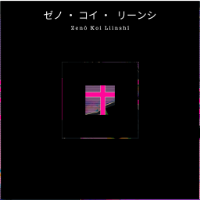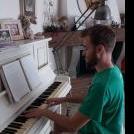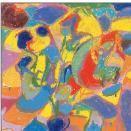Leaderboard
Popular Content
Showing content with the highest reputation on 06/28/2023 in all areas
-
Rusted Box in Wasteland (2022) written for solo piano explores the details of loneliness. In writing this piece, I had in mind a vast and desolate desert landscape, devoid of any other life. The only visual anchor was a giant, rusted box, as per the title. For the landscape, I crafted the piece to revolve around my synesthesia's dusty orange to represent the sandy landscape, its red for the box, and its purple as the individual experiencing the loneliness. Loneliness is often a nuanced experience. In one instance, it can be gentle or elegant--when you want to be alone. In another, it can anxiety-inducing, with paranoia and the fear of being alone forever. And in another, it can be a purely horrific and depressing experience--a downward spiral. Rusted Box in Wasteland represents this variety of feelings and experiences so that the listener can self-reflect on their own loneliness. Performed by Thomas Weaver of the Curtis Institute of Music on November 27th, 2022 Ca. 9 min Link to the performance:3 points
-
One day in spring when first awoken to sunlight I was immediately struck with melodies of a tune I made 3 years ago. I decided to give it an update in wait for the sunlight weather that has now arrived! is it time for breakfast already orchestrated score pdf.pdf is it time for breakfast already orchestrated.mp32 points
-
Hi guys, here's a wrote song I composed and recorded. Would enjoy hearing your thoughts. Thank you!1 point
-
1 point
-
A strange piece I just wrote that messes around with various things, like the whole tone row. (I was actually inspired to try my hand at whole tone row shenanigans after listening the Vince's 1st prelude here on the site.) My inspiration for the piece is somewhat complex. I titled it "The Guest Light" because, for one thing, I wanted to evoke the imagery of a surreal, semi-nightmarish thing. Like, there's an empty guest room in your house, and you know no one's in it, and yet the light is on: how? Why? But naming the piece "The Guest Light" is mainly not because of this made-up scenario, and this piece is not in any way intended to be programmatic. Rather, "The Guest Light" is a play on words for "The Gaslight"; in other words, someone or something trying to make you question your ability to perceive and understand reality the way it is. That's why this piece is full of really odd developmental decisions: false starts, cut off sections, weirdly repeated passages, and other things that are intended to throw the listener off. Let me know what you think 🤷♂️ P.S. My score is currently very messy, because I haven't cleaned up the articulations yet for the playback. Sorry about that, I'll clean it up later sometime. Update: Score has been cleaned up a lot.1 point
-
I love this combination, they are two of my favorite instruments, but to tell the truth, this is the first time I hear them in combination. And I love the music you wrote.1 point
-
There are descriptions from the cideo, here I just copypaste it here. Here you go, after a longgggg time, I have finally managed to release this xD The engraving is a disaster, because I used a MS3 beta feature, so that I could ignore the barlines. The drawback is that I cannot really save, as most of the times after I reopen it, the cross-bar notes are separated again.... So you could see I still have some minor errors (more than 3), mostly at the last sketch. Anyway, the work is written almost entirely in manuscript, with the last stretto section on 3rd sketch the only section that is composed on MS entirely. the first 2 sketches are completely on manuscript, with some deletion of notes due to the playability. 1st sketch is basically a preview of the whole work. It contains 3 segments both are introducing same theme and unique characteristics, with 1st and 3rd segment hinting at the following 2 sketches. This movement is named Allegro, only because it is the original tempo I set before, which turns out to be extremely difficult with the later 2 segments.... 2nd sketch is a quiet, crystal-like work with lots of fifths, except the middle section xD Named Amorioso, the tempo actually should be Amoroso, here however I follow what I have written in my manuscript. 3rd sketch is named Calmo, but the tempo here is just showing the first section of this sketch... The whole work is separated into 4 parts: Calmo - Chorale - Toccata - Stretto, with the latter 3 being veloce and sometimes struggling, kinda to do what 1st sketch cannot do lol The last Stretto section is the longest section of the work, even longer than the 1st sketch. It is a banger to me ever since when I was experimenting with the theme in 3rd sketch, and decided to make it as a finale of the whole set of sketches. It deserves its own sketch, really.... Anyway, this work is really personal: it is not classical, romantic or what. It is just me. Happy Birthday, myself 🥳 Hope you enjoy~~ (P.S. this set of sketches was written after I had heard the entirety of Sorabji's OC and SC.) Comments/opinions are welcome.1 point
-
This one was pretty wild to listen to, and it's been a while since I've listened to "Sorabji-like" music. I basically second Vince's opinion: I wasn't really "on board" throughout the first movement, but the second movement started to sway me, and the third movement eventually won me over. (The 3rd movement's initial theme sounds suspiciously like the famous Dies Irae theme, LOL. I'm 90% sure on purpose) The effort you put into the 3rd one is evident. The Toccata section sounds awesome, and is easily my favorite part of the entire work. I think the section just works really well in context, too, because the piece has a lot of muddy, thickly pedaled passages, with thick chords to boot, and then the toccata's crisp staccatos and thin bass octave accompaniment works as a welcome contrast. I do kind of crave a rit. and bigger cresc. at mss. 60 - 61 leading into ms. 62, I'm thinking that could be pretty effective. I actually really enjoyed this work. Thanks for sharing!1 point
-
Hey @GospelPiano12, Nice playing! I think the rhythm is accurate! However there are some pitches that appear to be wrong for me: B.2 "in the " should be G-A, b.3 "Name of" should be G and F. B.4 "Je" should be F, b.5 "sus" should be E B.10 "other_ should be G-A, b.11 "name" should be G B.14 "Call on his" should be A-G-A, b.15 "name" should be Bb. Henry1 point
-
Hi Willy, I know your feeling, but even the great composers are criticized with their masterpieces. Beethoven's late quartets were deemed "indecipherable, uncorrected horrors" by Spohr. Wolf criticized Brahms that his melodies were banal. Tchaikovsky's Violin Concerto was considered "long and pretentious". It's hard for others to have less positive views towards your own music, but I think that's a way for progress? Even if my view can be personal, I can say I'm honest and I hope it may help stimulate your thoughts! I have played the two pieces before. Although there are indeed spontaneous and improvisatory character, Brahms definitely plans with great care, as you can see with the developing variations and use of motives in both of the pieces. At least to my understanding both of his rhapsodies are in extended ternary form (and I'm checking the edition PETERs version on IMSLP right now and confirm it) They are indeed masterpieces full of virtuosic drama and passion, but they are treated under great care and planning, as Brahms is probably the composer care for cohesion more than any other composer. I love your piece, but it doesn't mean that I have to love it wholeheartedly and blindly, right? Beethoven's op,131 quartet is my all time favourite, but I can still find spots I don't agree on. Henry1 point
-
1 point
-
Although really cool, this feels like a series of disconnected virtuosic and showy passages with the only thing tieing them together into a coherent whole being the well known Rachmaninoff melody. You seem to have an aptitude for theme and variations much like myself! I love writing in the theme and variations form, but I often forget that theme and variations is actually just a compositional process and doesn't actually dictate any particular form besides just what the composer wants to imbue into it. If the composer doesn't imbue their theme and variations piece with ideas that tie the piece together formally, such as having an introduction or a rondo type of structure with built-in recapitulations, then the piece can feel like a series of sparsely connected ideas. Still, you're clearly a talented pianist-composer and I enjoy listening to your music! Thanks for sharing.1 point
-
Cool music Aled I like the alt-rock feel this has. Your voice reminds me of Les Claypool; I like the laugh part and the Beck-like rapping or talking sections. Cool drum parts and the guitar work is catchy. I love the guitar solo, nice wah moments before the gain really kicks in. The fast part at 3:25 was good, I would have maybe ended your solo with that, or extended the faster sections to the end, because it felt like it was about to build some energy but then just died. The tones are all great too. You had some nice moments with vibrato on held notes, I would have maybe added subtle vibrato to more of the notes though. I was once told to always add at least the slightest vibrato to any held note, and I'm a firm believer in that. That's just nitpicky though, I had to find something critical to say 😄 Nice work, and thanks for sharing this. I'm looking forward to more songs of this style by you!1 point
-
This may just be personal preference, but this was really hard to read. Why the insistence on 3 or 4 staves? Just curious The language you used was cool, care to share a bit more on it? What scales or harmonic structures were you thinking about when writing? I liked the 2nd and 3rd ones better than the first. At times it felt like you were writing this to make it difficult for difficulties sake. Interesting music, thanks for sharing 🙂1 point
-
I really appreciate some of Sorabji's works, and this is definitely a much more tamed Sorabji. I think these types of piano works can really bring out an expression that typical "tonal works" have trouble with. As discussed in the Discord, I think that the actual 4 stave system may be really difficult to read as a performer, although there is a huge "cool factor" when you see the piano score broken up this way. And your sheet music is beautiful! I see you've pushed the limits of MuseScore, which is cool! You definitely have a theme / motif, that you are incorporating in these sketches, and it's hard for me to point this out on text. But if I decide to record parts of this piece, I will point them out on a video review. I think doing an "atonal" work like this might be kind of interesting for my channel. This way Music Jotter is not just "associated" with classical music. But overall, I think this atonal piece is actually a great introductory piece to listen to for those who want to venture into this style. You have the style down quite well in my opinion, and it is fairly well structured from what my ears are telling me at least. There are parts of the recording that need my "nuancing" touches though, because the louder sections are way too mechanical. But I think with my techniques, we can turn those sections into some pretty convincing recordings. PS: I thought I was the only one who knew of Sorabji. Glad to see he has another fan.1 point








.thumb.png.8b5b433a341551e913a34392660bc95b.png)